MGT301 Leadership Essay: Authentic Leadership, LMX, PsyCap Analysis
VerifiedAdded on 2022/09/25
|13
|4107
|18
Essay
AI Summary
This essay delves into the intricate relationship between authentic leadership (AL), leader-member exchange (LMX), and employee psychological capital (PsyCap). It examines how AL, characterized by self-awareness, transparency, and ethical behavior, influences employee performance through LMX interactions, which, in turn, impact PsyCap. The essay reviews literature on building PsyCap across various employee groups, including professionals, administrative staff, and different generational cohorts, such as Baby Boomers, Generation X, and Millennials. It also explores the significance of positive emotions, work engagement, and the influence of demographic variables like ethnicity on the practice and understanding of AL. Furthermore, the essay underscores the importance of fostering a supportive organizational environment and how AL can benefit organizations, especially in challenging sectors like nursing, by promoting engagement and well-being. The study also investigates the impact of varying levels of PsyCap on the performance of followers in the context of LMX, and how positive emotions and psychological resources can contribute to employee engagement and organizational change. The essay also highlights the differences in work values and attitudes across generational cohorts and their implications for leadership practices. The essay concludes by assessing the role of employee emotions, leader behavior, and the impact of AL on work performance.

Running Head: MANAGEMENT 0
LEADERSHIP
LEADERSHIP
Paraphrase This Document
Need a fresh take? Get an instant paraphrase of this document with our AI Paraphraser
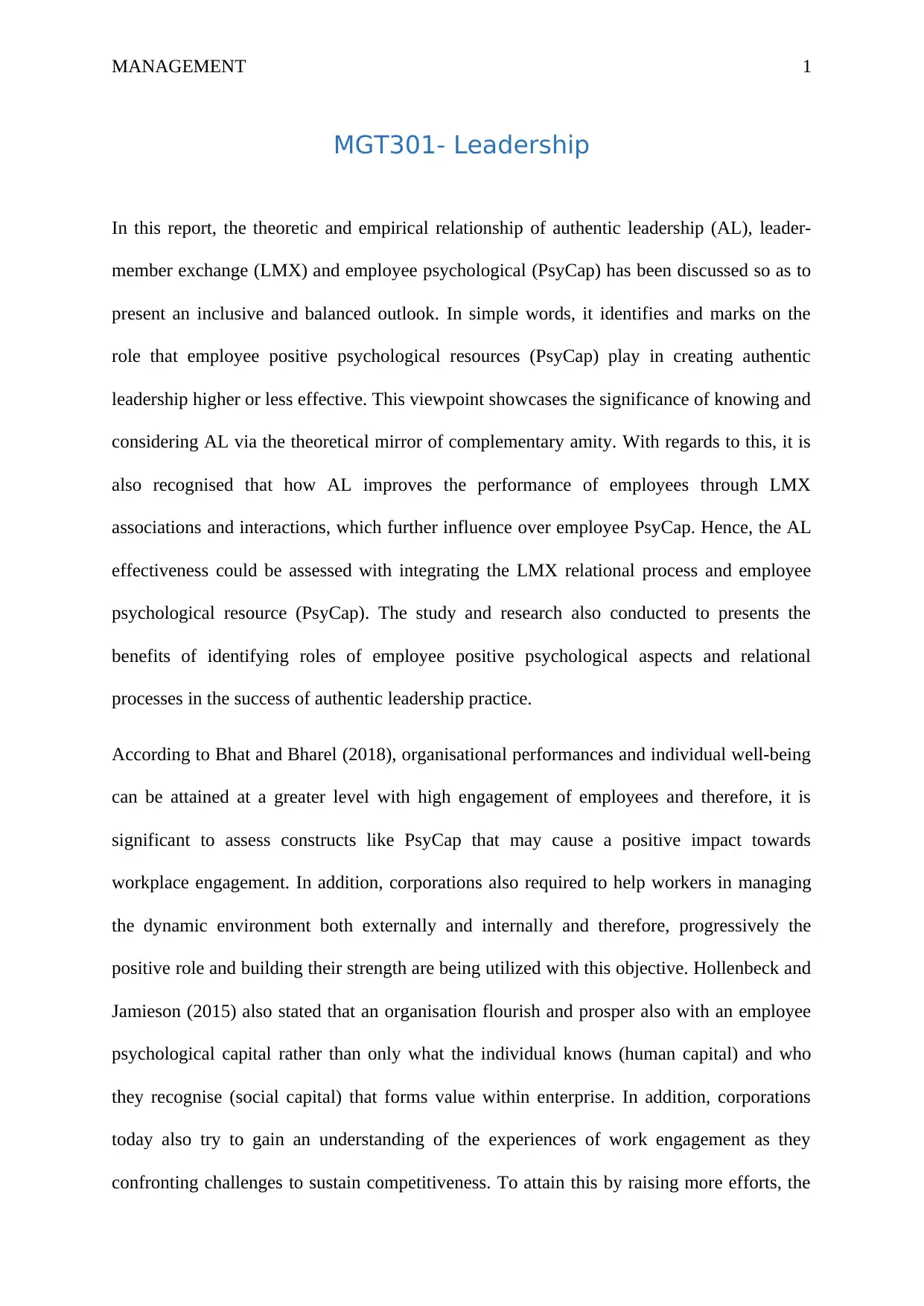
MANAGEMENT 1
MGT301- Leadership
In this report, the theoretic and empirical relationship of authentic leadership (AL), leader-
member exchange (LMX) and employee psychological (PsyCap) has been discussed so as to
present an inclusive and balanced outlook. In simple words, it identifies and marks on the
role that employee positive psychological resources (PsyCap) play in creating authentic
leadership higher or less effective. This viewpoint showcases the significance of knowing and
considering AL via the theoretical mirror of complementary amity. With regards to this, it is
also recognised that how AL improves the performance of employees through LMX
associations and interactions, which further influence over employee PsyCap. Hence, the AL
effectiveness could be assessed with integrating the LMX relational process and employee
psychological resource (PsyCap). The study and research also conducted to presents the
benefits of identifying roles of employee positive psychological aspects and relational
processes in the success of authentic leadership practice.
According to Bhat and Bharel (2018), organisational performances and individual well-being
can be attained at a greater level with high engagement of employees and therefore, it is
significant to assess constructs like PsyCap that may cause a positive impact towards
workplace engagement. In addition, corporations also required to help workers in managing
the dynamic environment both externally and internally and therefore, progressively the
positive role and building their strength are being utilized with this objective. Hollenbeck and
Jamieson (2015) also stated that an organisation flourish and prosper also with an employee
psychological capital rather than only what the individual knows (human capital) and who
they recognise (social capital) that forms value within enterprise. In addition, corporations
today also try to gain an understanding of the experiences of work engagement as they
confronting challenges to sustain competitiveness. To attain this by raising more efforts, the
MGT301- Leadership
In this report, the theoretic and empirical relationship of authentic leadership (AL), leader-
member exchange (LMX) and employee psychological (PsyCap) has been discussed so as to
present an inclusive and balanced outlook. In simple words, it identifies and marks on the
role that employee positive psychological resources (PsyCap) play in creating authentic
leadership higher or less effective. This viewpoint showcases the significance of knowing and
considering AL via the theoretical mirror of complementary amity. With regards to this, it is
also recognised that how AL improves the performance of employees through LMX
associations and interactions, which further influence over employee PsyCap. Hence, the AL
effectiveness could be assessed with integrating the LMX relational process and employee
psychological resource (PsyCap). The study and research also conducted to presents the
benefits of identifying roles of employee positive psychological aspects and relational
processes in the success of authentic leadership practice.
According to Bhat and Bharel (2018), organisational performances and individual well-being
can be attained at a greater level with high engagement of employees and therefore, it is
significant to assess constructs like PsyCap that may cause a positive impact towards
workplace engagement. In addition, corporations also required to help workers in managing
the dynamic environment both externally and internally and therefore, progressively the
positive role and building their strength are being utilized with this objective. Hollenbeck and
Jamieson (2015) also stated that an organisation flourish and prosper also with an employee
psychological capital rather than only what the individual knows (human capital) and who
they recognise (social capital) that forms value within enterprise. In addition, corporations
today also try to gain an understanding of the experiences of work engagement as they
confronting challenges to sustain competitiveness. To attain this by raising more efforts, the
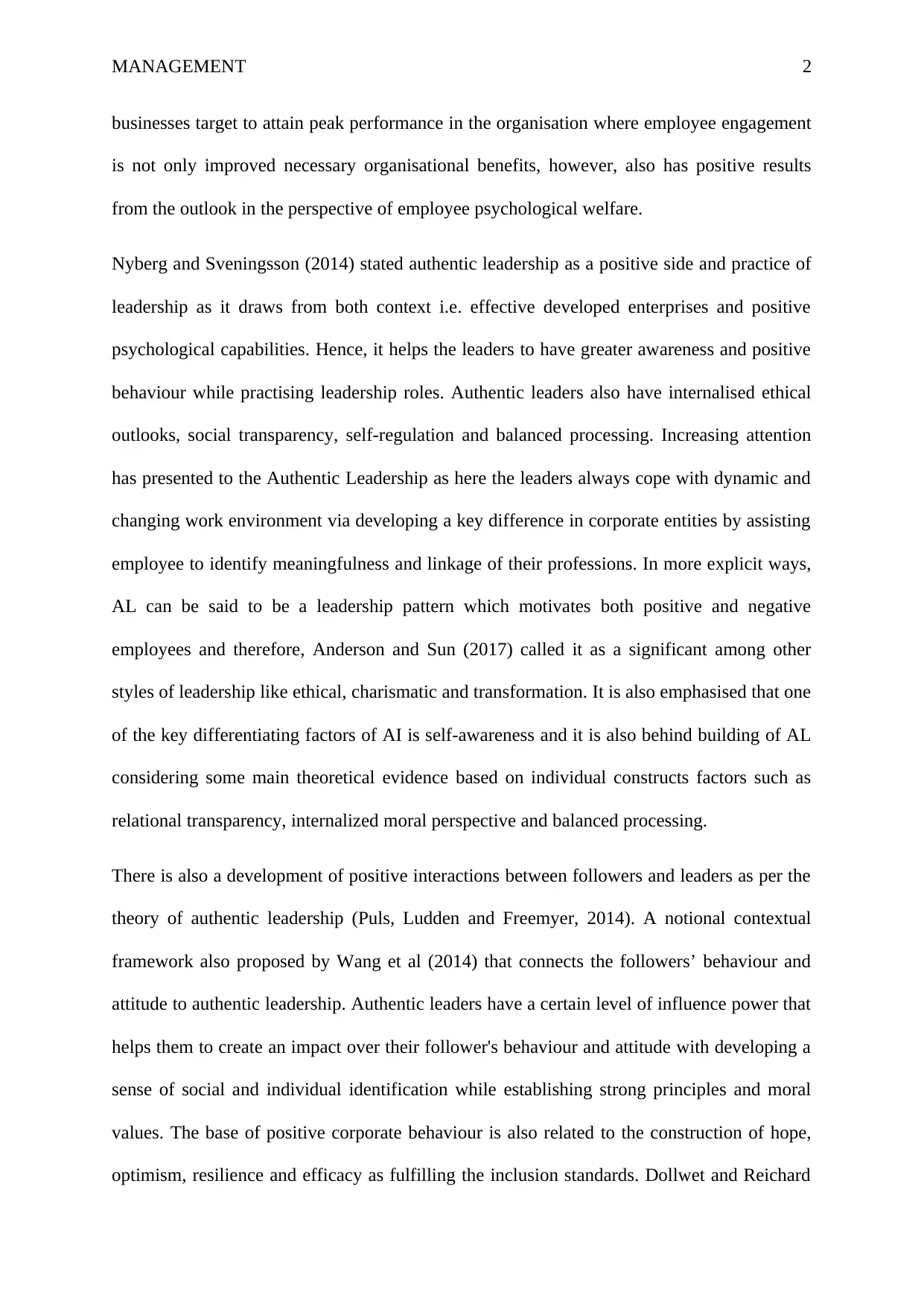
MANAGEMENT 2
businesses target to attain peak performance in the organisation where employee engagement
is not only improved necessary organisational benefits, however, also has positive results
from the outlook in the perspective of employee psychological welfare.
Nyberg and Sveningsson (2014) stated authentic leadership as a positive side and practice of
leadership as it draws from both context i.e. effective developed enterprises and positive
psychological capabilities. Hence, it helps the leaders to have greater awareness and positive
behaviour while practising leadership roles. Authentic leaders also have internalised ethical
outlooks, social transparency, self-regulation and balanced processing. Increasing attention
has presented to the Authentic Leadership as here the leaders always cope with dynamic and
changing work environment via developing a key difference in corporate entities by assisting
employee to identify meaningfulness and linkage of their professions. In more explicit ways,
AL can be said to be a leadership pattern which motivates both positive and negative
employees and therefore, Anderson and Sun (2017) called it as a significant among other
styles of leadership like ethical, charismatic and transformation. It is also emphasised that one
of the key differentiating factors of AI is self-awareness and it is also behind building of AL
considering some main theoretical evidence based on individual constructs factors such as
relational transparency, internalized moral perspective and balanced processing.
There is also a development of positive interactions between followers and leaders as per the
theory of authentic leadership (Puls, Ludden and Freemyer, 2014). A notional contextual
framework also proposed by Wang et al (2014) that connects the followers’ behaviour and
attitude to authentic leadership. Authentic leaders have a certain level of influence power that
helps them to create an impact over their follower's behaviour and attitude with developing a
sense of social and individual identification while establishing strong principles and moral
values. The base of positive corporate behaviour is also related to the construction of hope,
optimism, resilience and efficacy as fulfilling the inclusion standards. Dollwet and Reichard
businesses target to attain peak performance in the organisation where employee engagement
is not only improved necessary organisational benefits, however, also has positive results
from the outlook in the perspective of employee psychological welfare.
Nyberg and Sveningsson (2014) stated authentic leadership as a positive side and practice of
leadership as it draws from both context i.e. effective developed enterprises and positive
psychological capabilities. Hence, it helps the leaders to have greater awareness and positive
behaviour while practising leadership roles. Authentic leaders also have internalised ethical
outlooks, social transparency, self-regulation and balanced processing. Increasing attention
has presented to the Authentic Leadership as here the leaders always cope with dynamic and
changing work environment via developing a key difference in corporate entities by assisting
employee to identify meaningfulness and linkage of their professions. In more explicit ways,
AL can be said to be a leadership pattern which motivates both positive and negative
employees and therefore, Anderson and Sun (2017) called it as a significant among other
styles of leadership like ethical, charismatic and transformation. It is also emphasised that one
of the key differentiating factors of AI is self-awareness and it is also behind building of AL
considering some main theoretical evidence based on individual constructs factors such as
relational transparency, internalized moral perspective and balanced processing.
There is also a development of positive interactions between followers and leaders as per the
theory of authentic leadership (Puls, Ludden and Freemyer, 2014). A notional contextual
framework also proposed by Wang et al (2014) that connects the followers’ behaviour and
attitude to authentic leadership. Authentic leaders have a certain level of influence power that
helps them to create an impact over their follower's behaviour and attitude with developing a
sense of social and individual identification while establishing strong principles and moral
values. The base of positive corporate behaviour is also related to the construction of hope,
optimism, resilience and efficacy as fulfilling the inclusion standards. Dollwet and Reichard
⊘ This is a preview!⊘
Do you want full access?
Subscribe today to unlock all pages.

Trusted by 1+ million students worldwide
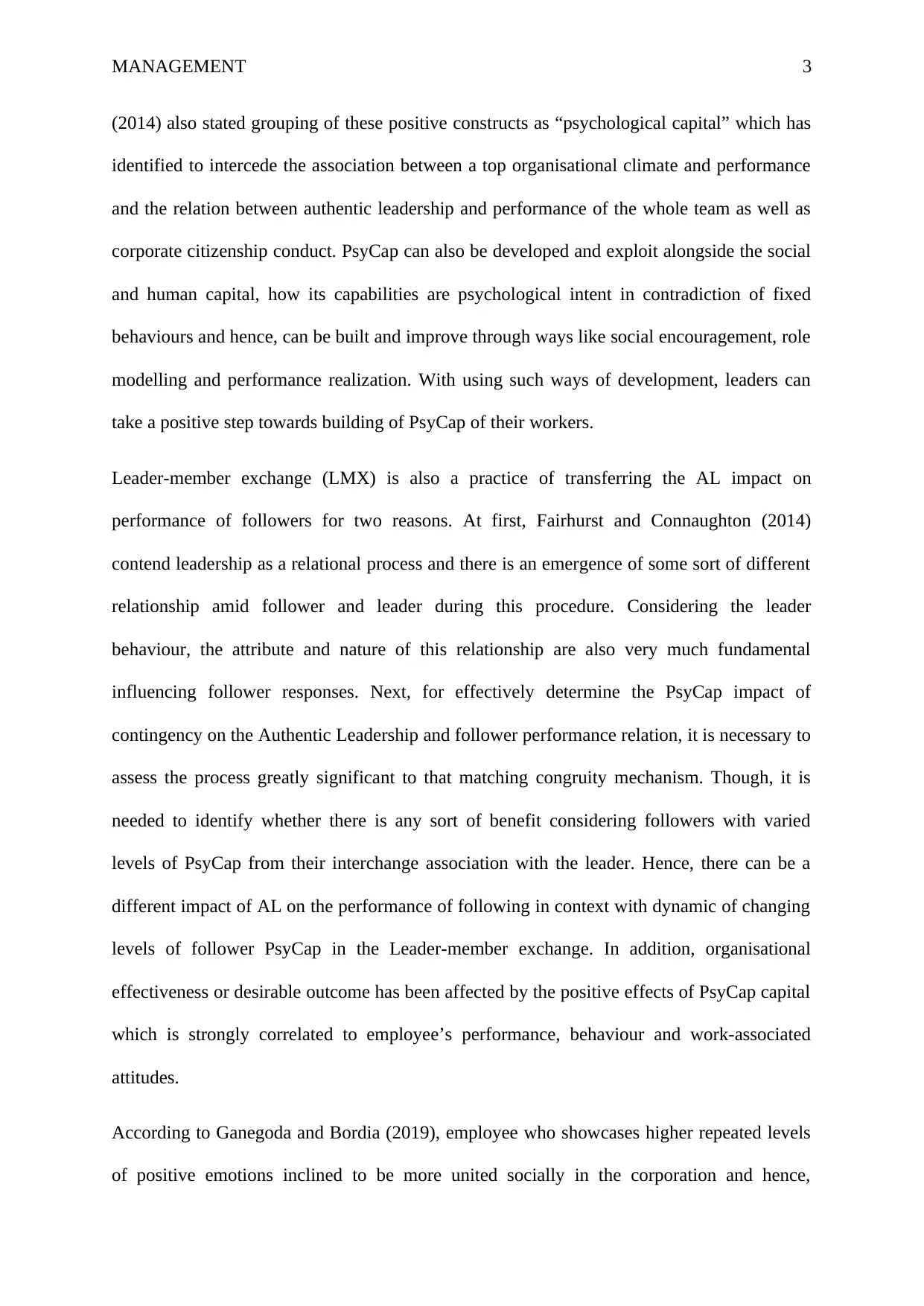
MANAGEMENT 3
(2014) also stated grouping of these positive constructs as “psychological capital” which has
identified to intercede the association between a top organisational climate and performance
and the relation between authentic leadership and performance of the whole team as well as
corporate citizenship conduct. PsyCap can also be developed and exploit alongside the social
and human capital, how its capabilities are psychological intent in contradiction of fixed
behaviours and hence, can be built and improve through ways like social encouragement, role
modelling and performance realization. With using such ways of development, leaders can
take a positive step towards building of PsyCap of their workers.
Leader-member exchange (LMX) is also a practice of transferring the AL impact on
performance of followers for two reasons. At first, Fairhurst and Connaughton (2014)
contend leadership as a relational process and there is an emergence of some sort of different
relationship amid follower and leader during this procedure. Considering the leader
behaviour, the attribute and nature of this relationship are also very much fundamental
influencing follower responses. Next, for effectively determine the PsyCap impact of
contingency on the Authentic Leadership and follower performance relation, it is necessary to
assess the process greatly significant to that matching congruity mechanism. Though, it is
needed to identify whether there is any sort of benefit considering followers with varied
levels of PsyCap from their interchange association with the leader. Hence, there can be a
different impact of AL on the performance of following in context with dynamic of changing
levels of follower PsyCap in the Leader-member exchange. In addition, organisational
effectiveness or desirable outcome has been affected by the positive effects of PsyCap capital
which is strongly correlated to employee’s performance, behaviour and work-associated
attitudes.
According to Ganegoda and Bordia (2019), employee who showcases higher repeated levels
of positive emotions inclined to be more united socially in the corporation and hence,
(2014) also stated grouping of these positive constructs as “psychological capital” which has
identified to intercede the association between a top organisational climate and performance
and the relation between authentic leadership and performance of the whole team as well as
corporate citizenship conduct. PsyCap can also be developed and exploit alongside the social
and human capital, how its capabilities are psychological intent in contradiction of fixed
behaviours and hence, can be built and improve through ways like social encouragement, role
modelling and performance realization. With using such ways of development, leaders can
take a positive step towards building of PsyCap of their workers.
Leader-member exchange (LMX) is also a practice of transferring the AL impact on
performance of followers for two reasons. At first, Fairhurst and Connaughton (2014)
contend leadership as a relational process and there is an emergence of some sort of different
relationship amid follower and leader during this procedure. Considering the leader
behaviour, the attribute and nature of this relationship are also very much fundamental
influencing follower responses. Next, for effectively determine the PsyCap impact of
contingency on the Authentic Leadership and follower performance relation, it is necessary to
assess the process greatly significant to that matching congruity mechanism. Though, it is
needed to identify whether there is any sort of benefit considering followers with varied
levels of PsyCap from their interchange association with the leader. Hence, there can be a
different impact of AL on the performance of following in context with dynamic of changing
levels of follower PsyCap in the Leader-member exchange. In addition, organisational
effectiveness or desirable outcome has been affected by the positive effects of PsyCap capital
which is strongly correlated to employee’s performance, behaviour and work-associated
attitudes.
According to Ganegoda and Bordia (2019), employee who showcases higher repeated levels
of positive emotions inclined to be more united socially in the corporation and hence,
Paraphrase This Document
Need a fresh take? Get an instant paraphrase of this document with our AI Paraphraser
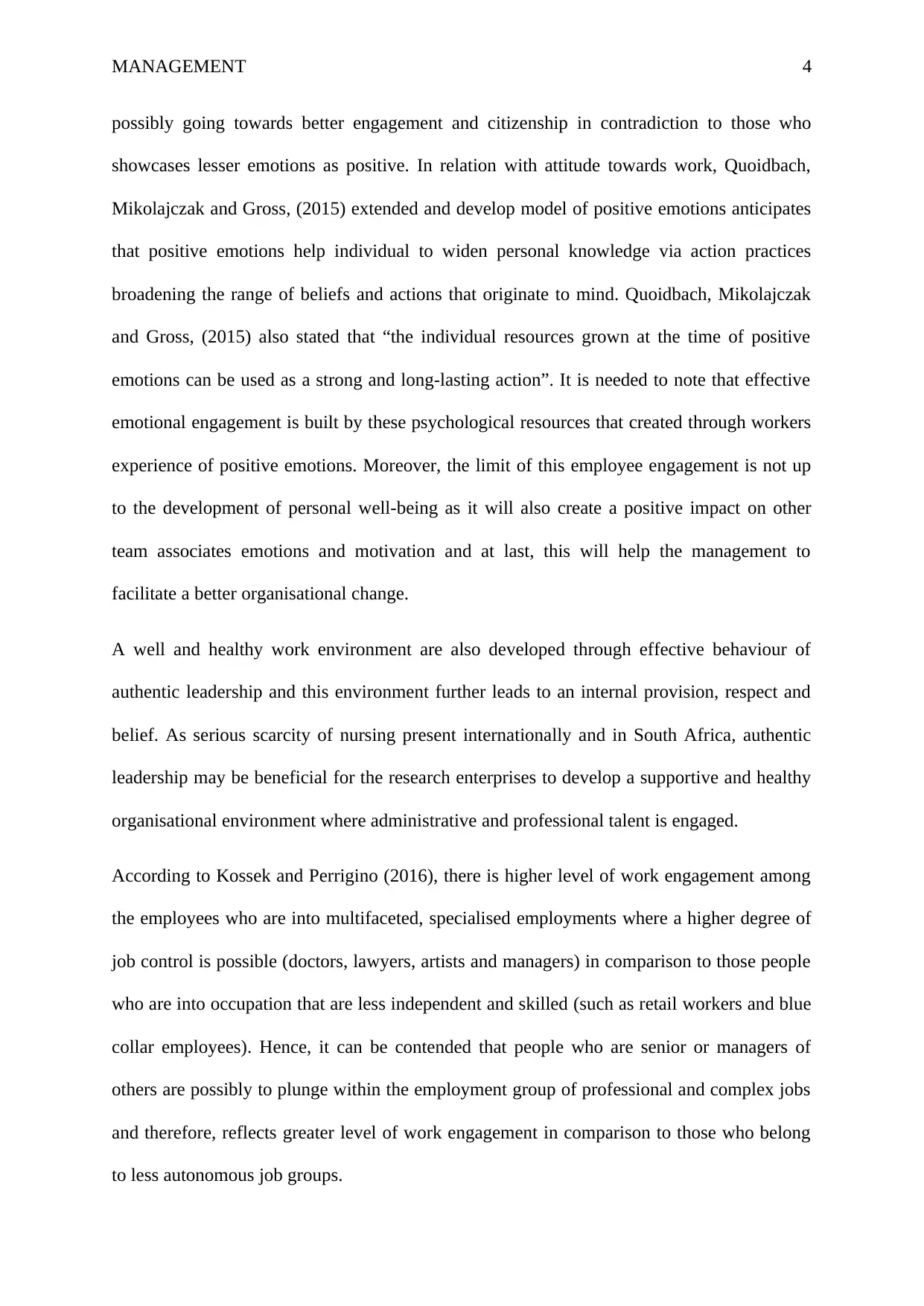
MANAGEMENT 4
possibly going towards better engagement and citizenship in contradiction to those who
showcases lesser emotions as positive. In relation with attitude towards work, Quoidbach,
Mikolajczak and Gross, (2015) extended and develop model of positive emotions anticipates
that positive emotions help individual to widen personal knowledge via action practices
broadening the range of beliefs and actions that originate to mind. Quoidbach, Mikolajczak
and Gross, (2015) also stated that “the individual resources grown at the time of positive
emotions can be used as a strong and long-lasting action”. It is needed to note that effective
emotional engagement is built by these psychological resources that created through workers
experience of positive emotions. Moreover, the limit of this employee engagement is not up
to the development of personal well-being as it will also create a positive impact on other
team associates emotions and motivation and at last, this will help the management to
facilitate a better organisational change.
A well and healthy work environment are also developed through effective behaviour of
authentic leadership and this environment further leads to an internal provision, respect and
belief. As serious scarcity of nursing present internationally and in South Africa, authentic
leadership may be beneficial for the research enterprises to develop a supportive and healthy
organisational environment where administrative and professional talent is engaged.
According to Kossek and Perrigino (2016), there is higher level of work engagement among
the employees who are into multifaceted, specialised employments where a higher degree of
job control is possible (doctors, lawyers, artists and managers) in comparison to those people
who are into occupation that are less independent and skilled (such as retail workers and blue
collar employees). Hence, it can be contended that people who are senior or managers of
others are possibly to plunge within the employment group of professional and complex jobs
and therefore, reflects greater level of work engagement in comparison to those who belong
to less autonomous job groups.
possibly going towards better engagement and citizenship in contradiction to those who
showcases lesser emotions as positive. In relation with attitude towards work, Quoidbach,
Mikolajczak and Gross, (2015) extended and develop model of positive emotions anticipates
that positive emotions help individual to widen personal knowledge via action practices
broadening the range of beliefs and actions that originate to mind. Quoidbach, Mikolajczak
and Gross, (2015) also stated that “the individual resources grown at the time of positive
emotions can be used as a strong and long-lasting action”. It is needed to note that effective
emotional engagement is built by these psychological resources that created through workers
experience of positive emotions. Moreover, the limit of this employee engagement is not up
to the development of personal well-being as it will also create a positive impact on other
team associates emotions and motivation and at last, this will help the management to
facilitate a better organisational change.
A well and healthy work environment are also developed through effective behaviour of
authentic leadership and this environment further leads to an internal provision, respect and
belief. As serious scarcity of nursing present internationally and in South Africa, authentic
leadership may be beneficial for the research enterprises to develop a supportive and healthy
organisational environment where administrative and professional talent is engaged.
According to Kossek and Perrigino (2016), there is higher level of work engagement among
the employees who are into multifaceted, specialised employments where a higher degree of
job control is possible (doctors, lawyers, artists and managers) in comparison to those people
who are into occupation that are less independent and skilled (such as retail workers and blue
collar employees). Hence, it can be contended that people who are senior or managers of
others are possibly to plunge within the employment group of professional and complex jobs
and therefore, reflects greater level of work engagement in comparison to those who belong
to less autonomous job groups.
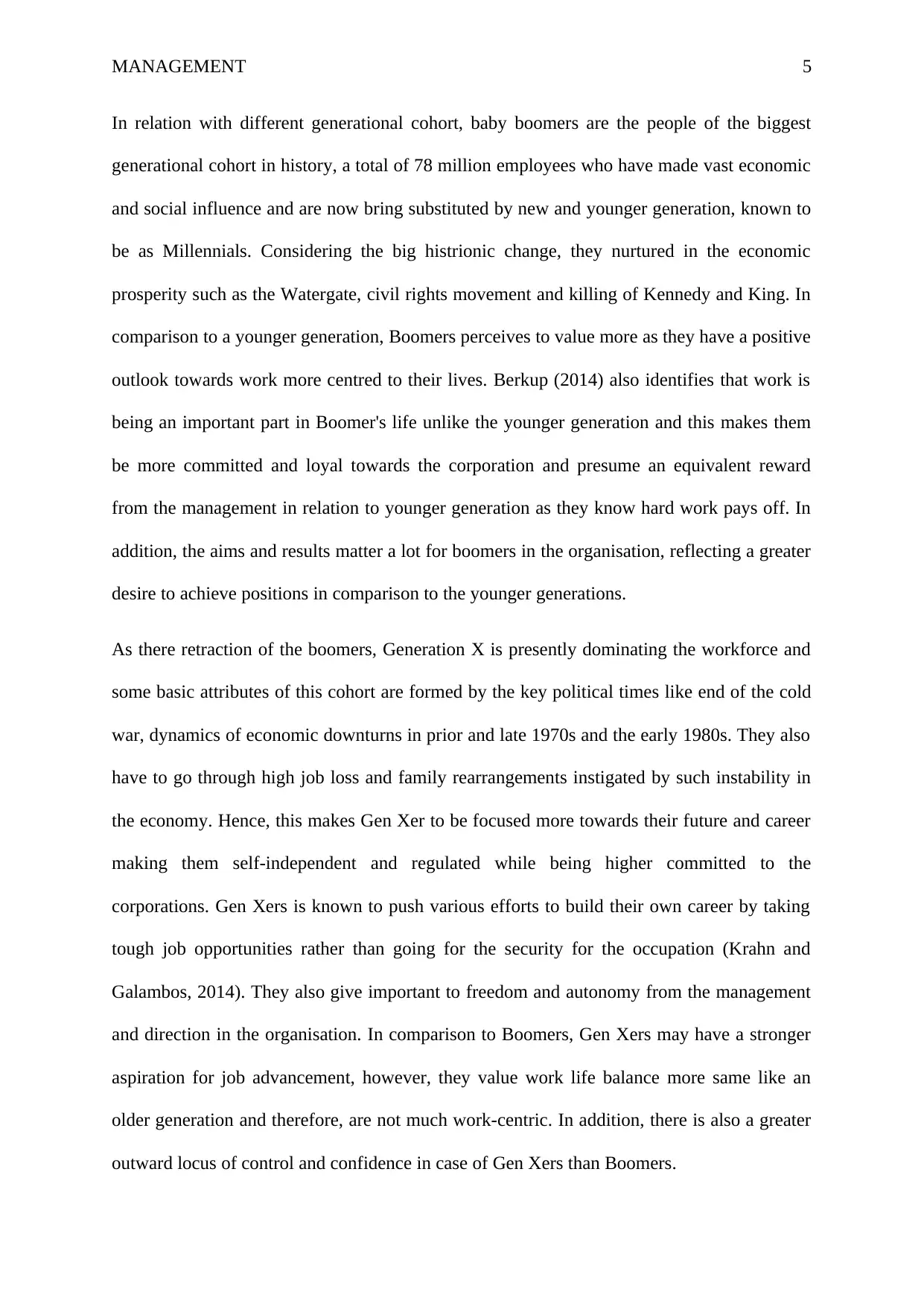
MANAGEMENT 5
In relation with different generational cohort, baby boomers are the people of the biggest
generational cohort in history, a total of 78 million employees who have made vast economic
and social influence and are now bring substituted by new and younger generation, known to
be as Millennials. Considering the big histrionic change, they nurtured in the economic
prosperity such as the Watergate, civil rights movement and killing of Kennedy and King. In
comparison to a younger generation, Boomers perceives to value more as they have a positive
outlook towards work more centred to their lives. Berkup (2014) also identifies that work is
being an important part in Boomer's life unlike the younger generation and this makes them
be more committed and loyal towards the corporation and presume an equivalent reward
from the management in relation to younger generation as they know hard work pays off. In
addition, the aims and results matter a lot for boomers in the organisation, reflecting a greater
desire to achieve positions in comparison to the younger generations.
As there retraction of the boomers, Generation X is presently dominating the workforce and
some basic attributes of this cohort are formed by the key political times like end of the cold
war, dynamics of economic downturns in prior and late 1970s and the early 1980s. They also
have to go through high job loss and family rearrangements instigated by such instability in
the economy. Hence, this makes Gen Xer to be focused more towards their future and career
making them self-independent and regulated while being higher committed to the
corporations. Gen Xers is known to push various efforts to build their own career by taking
tough job opportunities rather than going for the security for the occupation (Krahn and
Galambos, 2014). They also give important to freedom and autonomy from the management
and direction in the organisation. In comparison to Boomers, Gen Xers may have a stronger
aspiration for job advancement, however, they value work life balance more same like an
older generation and therefore, are not much work-centric. In addition, there is also a greater
outward locus of control and confidence in case of Gen Xers than Boomers.
In relation with different generational cohort, baby boomers are the people of the biggest
generational cohort in history, a total of 78 million employees who have made vast economic
and social influence and are now bring substituted by new and younger generation, known to
be as Millennials. Considering the big histrionic change, they nurtured in the economic
prosperity such as the Watergate, civil rights movement and killing of Kennedy and King. In
comparison to a younger generation, Boomers perceives to value more as they have a positive
outlook towards work more centred to their lives. Berkup (2014) also identifies that work is
being an important part in Boomer's life unlike the younger generation and this makes them
be more committed and loyal towards the corporation and presume an equivalent reward
from the management in relation to younger generation as they know hard work pays off. In
addition, the aims and results matter a lot for boomers in the organisation, reflecting a greater
desire to achieve positions in comparison to the younger generations.
As there retraction of the boomers, Generation X is presently dominating the workforce and
some basic attributes of this cohort are formed by the key political times like end of the cold
war, dynamics of economic downturns in prior and late 1970s and the early 1980s. They also
have to go through high job loss and family rearrangements instigated by such instability in
the economy. Hence, this makes Gen Xer to be focused more towards their future and career
making them self-independent and regulated while being higher committed to the
corporations. Gen Xers is known to push various efforts to build their own career by taking
tough job opportunities rather than going for the security for the occupation (Krahn and
Galambos, 2014). They also give important to freedom and autonomy from the management
and direction in the organisation. In comparison to Boomers, Gen Xers may have a stronger
aspiration for job advancement, however, they value work life balance more same like an
older generation and therefore, are not much work-centric. In addition, there is also a greater
outward locus of control and confidence in case of Gen Xers than Boomers.
⊘ This is a preview!⊘
Do you want full access?
Subscribe today to unlock all pages.

Trusted by 1+ million students worldwide
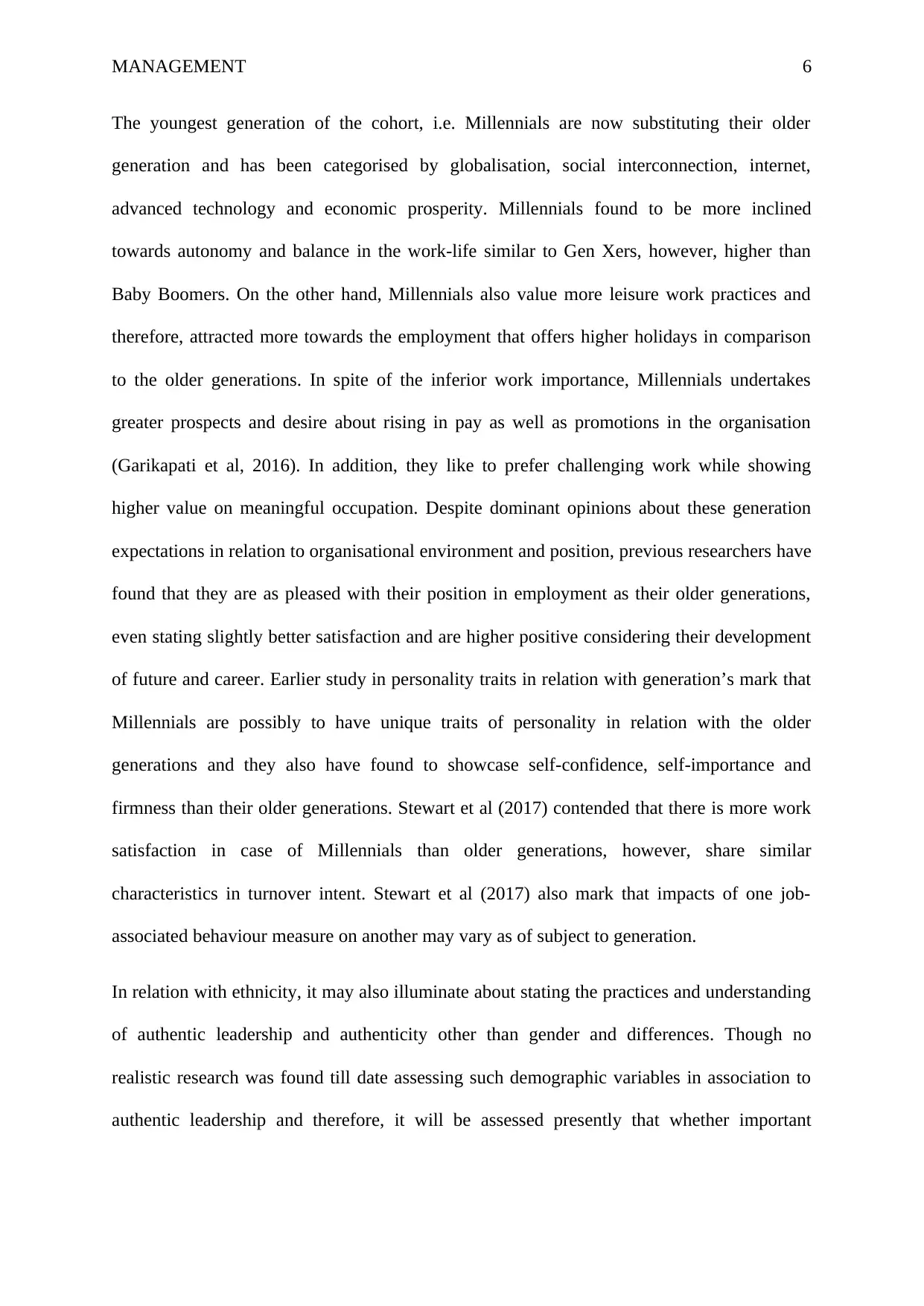
MANAGEMENT 6
The youngest generation of the cohort, i.e. Millennials are now substituting their older
generation and has been categorised by globalisation, social interconnection, internet,
advanced technology and economic prosperity. Millennials found to be more inclined
towards autonomy and balance in the work-life similar to Gen Xers, however, higher than
Baby Boomers. On the other hand, Millennials also value more leisure work practices and
therefore, attracted more towards the employment that offers higher holidays in comparison
to the older generations. In spite of the inferior work importance, Millennials undertakes
greater prospects and desire about rising in pay as well as promotions in the organisation
(Garikapati et al, 2016). In addition, they like to prefer challenging work while showing
higher value on meaningful occupation. Despite dominant opinions about these generation
expectations in relation to organisational environment and position, previous researchers have
found that they are as pleased with their position in employment as their older generations,
even stating slightly better satisfaction and are higher positive considering their development
of future and career. Earlier study in personality traits in relation with generation’s mark that
Millennials are possibly to have unique traits of personality in relation with the older
generations and they also have found to showcase self-confidence, self-importance and
firmness than their older generations. Stewart et al (2017) contended that there is more work
satisfaction in case of Millennials than older generations, however, share similar
characteristics in turnover intent. Stewart et al (2017) also mark that impacts of one job-
associated behaviour measure on another may vary as of subject to generation.
In relation with ethnicity, it may also illuminate about stating the practices and understanding
of authentic leadership and authenticity other than gender and differences. Though no
realistic research was found till date assessing such demographic variables in association to
authentic leadership and therefore, it will be assessed presently that whether important
The youngest generation of the cohort, i.e. Millennials are now substituting their older
generation and has been categorised by globalisation, social interconnection, internet,
advanced technology and economic prosperity. Millennials found to be more inclined
towards autonomy and balance in the work-life similar to Gen Xers, however, higher than
Baby Boomers. On the other hand, Millennials also value more leisure work practices and
therefore, attracted more towards the employment that offers higher holidays in comparison
to the older generations. In spite of the inferior work importance, Millennials undertakes
greater prospects and desire about rising in pay as well as promotions in the organisation
(Garikapati et al, 2016). In addition, they like to prefer challenging work while showing
higher value on meaningful occupation. Despite dominant opinions about these generation
expectations in relation to organisational environment and position, previous researchers have
found that they are as pleased with their position in employment as their older generations,
even stating slightly better satisfaction and are higher positive considering their development
of future and career. Earlier study in personality traits in relation with generation’s mark that
Millennials are possibly to have unique traits of personality in relation with the older
generations and they also have found to showcase self-confidence, self-importance and
firmness than their older generations. Stewart et al (2017) contended that there is more work
satisfaction in case of Millennials than older generations, however, share similar
characteristics in turnover intent. Stewart et al (2017) also mark that impacts of one job-
associated behaviour measure on another may vary as of subject to generation.
In relation with ethnicity, it may also illuminate about stating the practices and understanding
of authentic leadership and authenticity other than gender and differences. Though no
realistic research was found till date assessing such demographic variables in association to
authentic leadership and therefore, it will be assessed presently that whether important
Paraphrase This Document
Need a fresh take? Get an instant paraphrase of this document with our AI Paraphraser
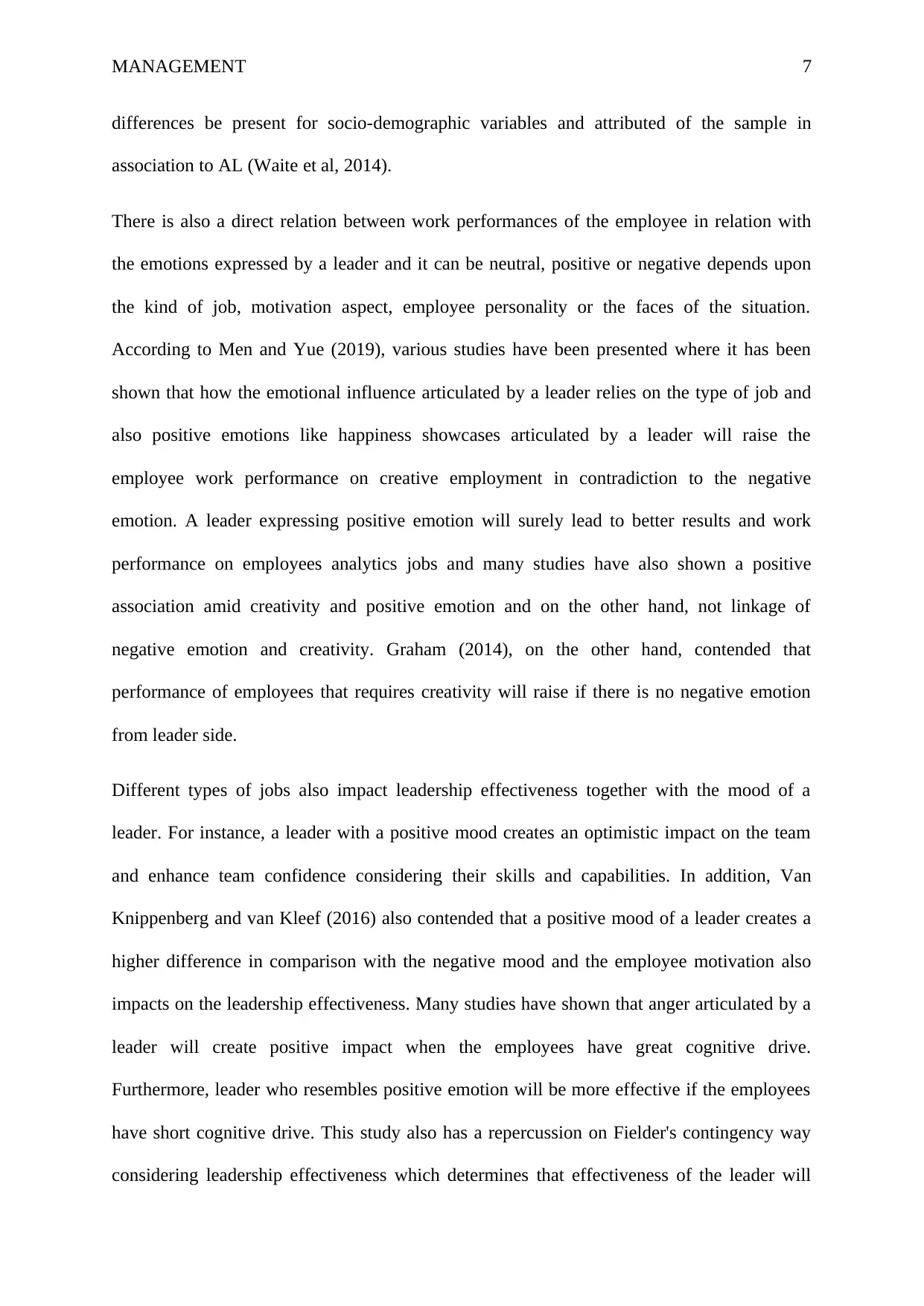
MANAGEMENT 7
differences be present for socio-demographic variables and attributed of the sample in
association to AL (Waite et al, 2014).
There is also a direct relation between work performances of the employee in relation with
the emotions expressed by a leader and it can be neutral, positive or negative depends upon
the kind of job, motivation aspect, employee personality or the faces of the situation.
According to Men and Yue (2019), various studies have been presented where it has been
shown that how the emotional influence articulated by a leader relies on the type of job and
also positive emotions like happiness showcases articulated by a leader will raise the
employee work performance on creative employment in contradiction to the negative
emotion. A leader expressing positive emotion will surely lead to better results and work
performance on employees analytics jobs and many studies have also shown a positive
association amid creativity and positive emotion and on the other hand, not linkage of
negative emotion and creativity. Graham (2014), on the other hand, contended that
performance of employees that requires creativity will raise if there is no negative emotion
from leader side.
Different types of jobs also impact leadership effectiveness together with the mood of a
leader. For instance, a leader with a positive mood creates an optimistic impact on the team
and enhance team confidence considering their skills and capabilities. In addition, Van
Knippenberg and van Kleef (2016) also contended that a positive mood of a leader creates a
higher difference in comparison with the negative mood and the employee motivation also
impacts on the leadership effectiveness. Many studies have shown that anger articulated by a
leader will create positive impact when the employees have great cognitive drive.
Furthermore, leader who resembles positive emotion will be more effective if the employees
have short cognitive drive. This study also has a repercussion on Fielder's contingency way
considering leadership effectiveness which determines that effectiveness of the leader will
differences be present for socio-demographic variables and attributed of the sample in
association to AL (Waite et al, 2014).
There is also a direct relation between work performances of the employee in relation with
the emotions expressed by a leader and it can be neutral, positive or negative depends upon
the kind of job, motivation aspect, employee personality or the faces of the situation.
According to Men and Yue (2019), various studies have been presented where it has been
shown that how the emotional influence articulated by a leader relies on the type of job and
also positive emotions like happiness showcases articulated by a leader will raise the
employee work performance on creative employment in contradiction to the negative
emotion. A leader expressing positive emotion will surely lead to better results and work
performance on employees analytics jobs and many studies have also shown a positive
association amid creativity and positive emotion and on the other hand, not linkage of
negative emotion and creativity. Graham (2014), on the other hand, contended that
performance of employees that requires creativity will raise if there is no negative emotion
from leader side.
Different types of jobs also impact leadership effectiveness together with the mood of a
leader. For instance, a leader with a positive mood creates an optimistic impact on the team
and enhance team confidence considering their skills and capabilities. In addition, Van
Knippenberg and van Kleef (2016) also contended that a positive mood of a leader creates a
higher difference in comparison with the negative mood and the employee motivation also
impacts on the leadership effectiveness. Many studies have shown that anger articulated by a
leader will create positive impact when the employees have great cognitive drive.
Furthermore, leader who resembles positive emotion will be more effective if the employees
have short cognitive drive. This study also has a repercussion on Fielder's contingency way
considering leadership effectiveness which determines that effectiveness of the leader will
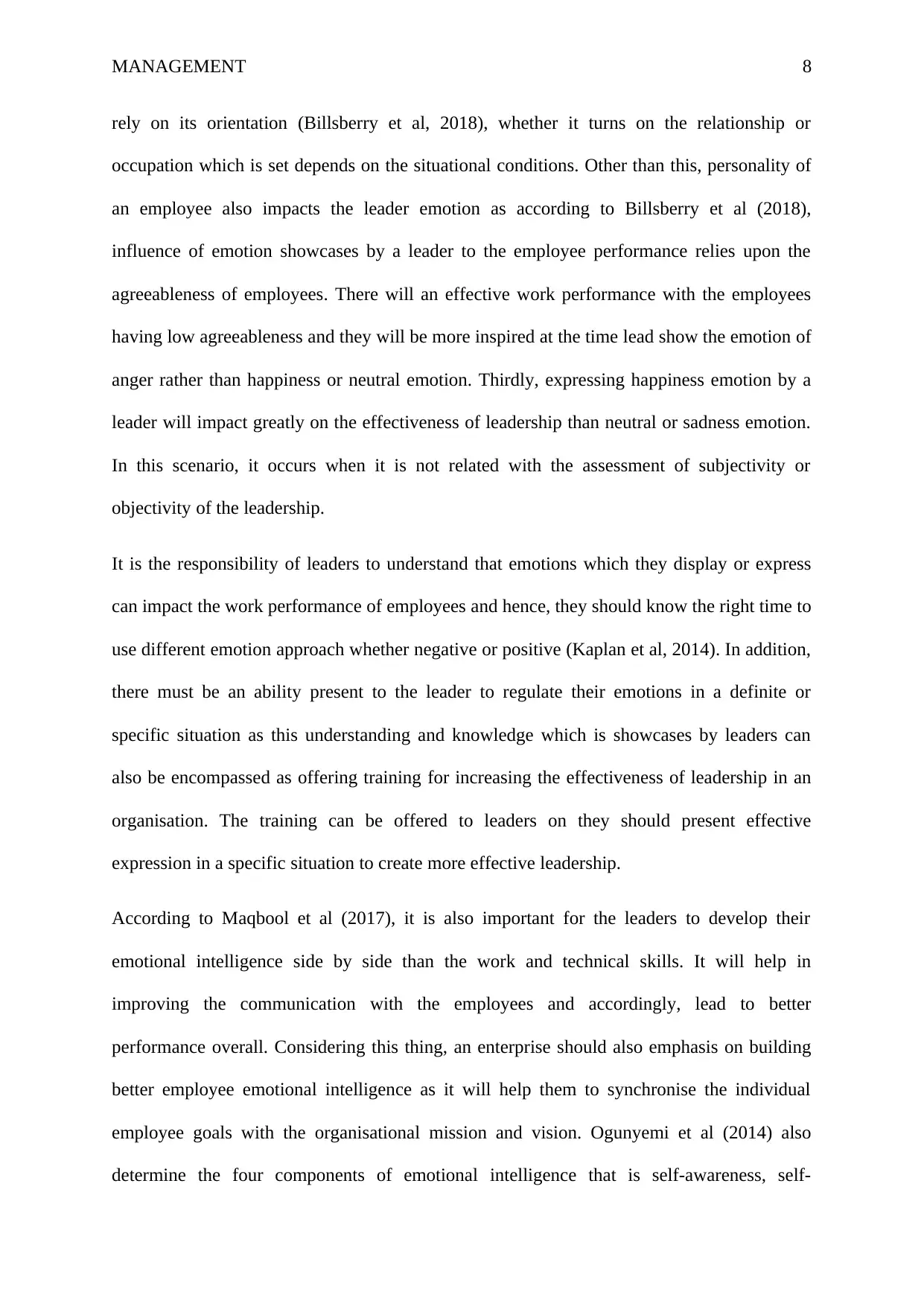
MANAGEMENT 8
rely on its orientation (Billsberry et al, 2018), whether it turns on the relationship or
occupation which is set depends on the situational conditions. Other than this, personality of
an employee also impacts the leader emotion as according to Billsberry et al (2018),
influence of emotion showcases by a leader to the employee performance relies upon the
agreeableness of employees. There will an effective work performance with the employees
having low agreeableness and they will be more inspired at the time lead show the emotion of
anger rather than happiness or neutral emotion. Thirdly, expressing happiness emotion by a
leader will impact greatly on the effectiveness of leadership than neutral or sadness emotion.
In this scenario, it occurs when it is not related with the assessment of subjectivity or
objectivity of the leadership.
It is the responsibility of leaders to understand that emotions which they display or express
can impact the work performance of employees and hence, they should know the right time to
use different emotion approach whether negative or positive (Kaplan et al, 2014). In addition,
there must be an ability present to the leader to regulate their emotions in a definite or
specific situation as this understanding and knowledge which is showcases by leaders can
also be encompassed as offering training for increasing the effectiveness of leadership in an
organisation. The training can be offered to leaders on they should present effective
expression in a specific situation to create more effective leadership.
According to Maqbool et al (2017), it is also important for the leaders to develop their
emotional intelligence side by side than the work and technical skills. It will help in
improving the communication with the employees and accordingly, lead to better
performance overall. Considering this thing, an enterprise should also emphasis on building
better employee emotional intelligence as it will help them to synchronise the individual
employee goals with the organisational mission and vision. Ogunyemi et al (2014) also
determine the four components of emotional intelligence that is self-awareness, self-
rely on its orientation (Billsberry et al, 2018), whether it turns on the relationship or
occupation which is set depends on the situational conditions. Other than this, personality of
an employee also impacts the leader emotion as according to Billsberry et al (2018),
influence of emotion showcases by a leader to the employee performance relies upon the
agreeableness of employees. There will an effective work performance with the employees
having low agreeableness and they will be more inspired at the time lead show the emotion of
anger rather than happiness or neutral emotion. Thirdly, expressing happiness emotion by a
leader will impact greatly on the effectiveness of leadership than neutral or sadness emotion.
In this scenario, it occurs when it is not related with the assessment of subjectivity or
objectivity of the leadership.
It is the responsibility of leaders to understand that emotions which they display or express
can impact the work performance of employees and hence, they should know the right time to
use different emotion approach whether negative or positive (Kaplan et al, 2014). In addition,
there must be an ability present to the leader to regulate their emotions in a definite or
specific situation as this understanding and knowledge which is showcases by leaders can
also be encompassed as offering training for increasing the effectiveness of leadership in an
organisation. The training can be offered to leaders on they should present effective
expression in a specific situation to create more effective leadership.
According to Maqbool et al (2017), it is also important for the leaders to develop their
emotional intelligence side by side than the work and technical skills. It will help in
improving the communication with the employees and accordingly, lead to better
performance overall. Considering this thing, an enterprise should also emphasis on building
better employee emotional intelligence as it will help them to synchronise the individual
employee goals with the organisational mission and vision. Ogunyemi et al (2014) also
determine the four components of emotional intelligence that is self-awareness, self-
⊘ This is a preview!⊘
Do you want full access?
Subscribe today to unlock all pages.

Trusted by 1+ million students worldwide
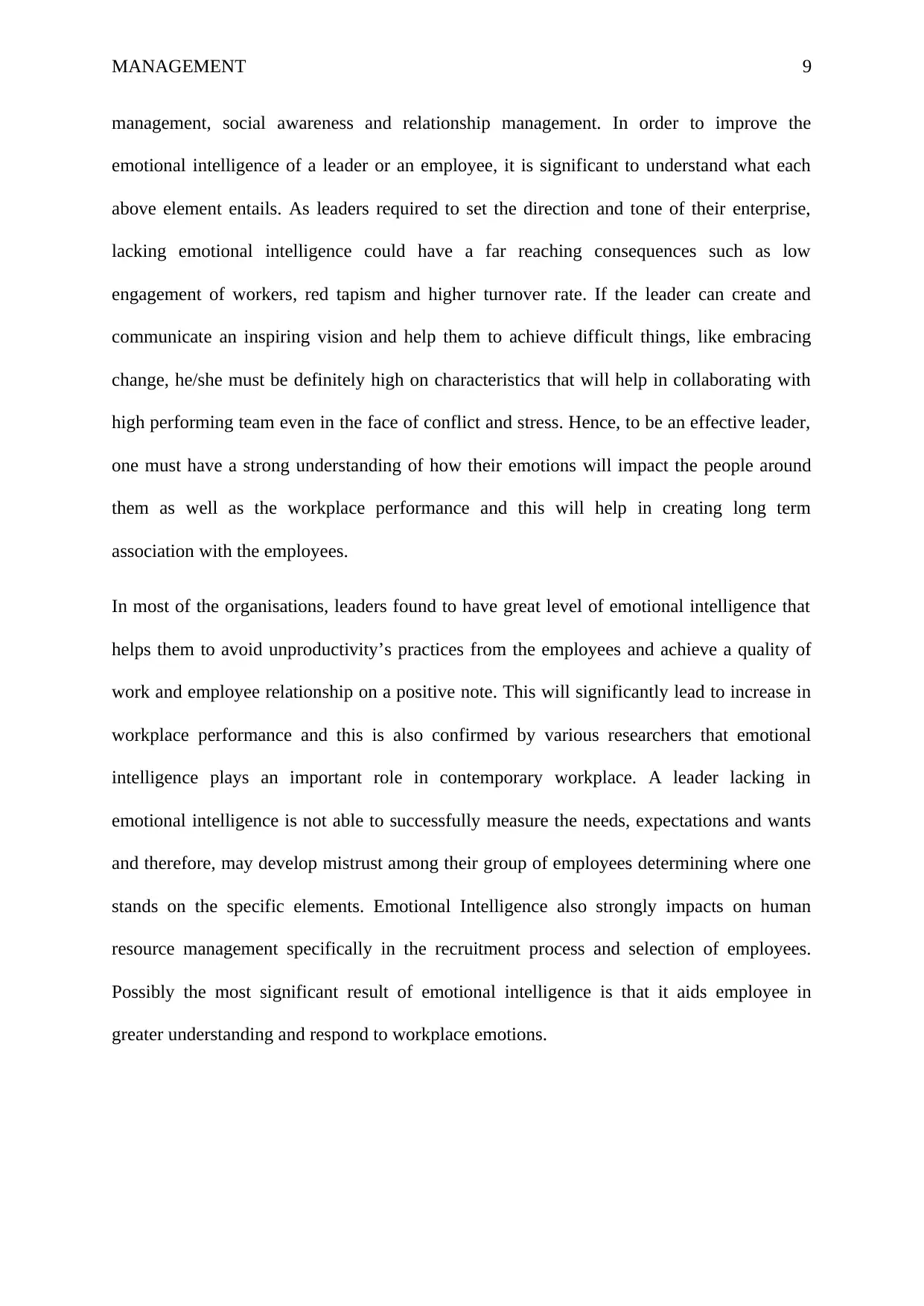
MANAGEMENT 9
management, social awareness and relationship management. In order to improve the
emotional intelligence of a leader or an employee, it is significant to understand what each
above element entails. As leaders required to set the direction and tone of their enterprise,
lacking emotional intelligence could have a far reaching consequences such as low
engagement of workers, red tapism and higher turnover rate. If the leader can create and
communicate an inspiring vision and help them to achieve difficult things, like embracing
change, he/she must be definitely high on characteristics that will help in collaborating with
high performing team even in the face of conflict and stress. Hence, to be an effective leader,
one must have a strong understanding of how their emotions will impact the people around
them as well as the workplace performance and this will help in creating long term
association with the employees.
In most of the organisations, leaders found to have great level of emotional intelligence that
helps them to avoid unproductivity’s practices from the employees and achieve a quality of
work and employee relationship on a positive note. This will significantly lead to increase in
workplace performance and this is also confirmed by various researchers that emotional
intelligence plays an important role in contemporary workplace. A leader lacking in
emotional intelligence is not able to successfully measure the needs, expectations and wants
and therefore, may develop mistrust among their group of employees determining where one
stands on the specific elements. Emotional Intelligence also strongly impacts on human
resource management specifically in the recruitment process and selection of employees.
Possibly the most significant result of emotional intelligence is that it aids employee in
greater understanding and respond to workplace emotions.
management, social awareness and relationship management. In order to improve the
emotional intelligence of a leader or an employee, it is significant to understand what each
above element entails. As leaders required to set the direction and tone of their enterprise,
lacking emotional intelligence could have a far reaching consequences such as low
engagement of workers, red tapism and higher turnover rate. If the leader can create and
communicate an inspiring vision and help them to achieve difficult things, like embracing
change, he/she must be definitely high on characteristics that will help in collaborating with
high performing team even in the face of conflict and stress. Hence, to be an effective leader,
one must have a strong understanding of how their emotions will impact the people around
them as well as the workplace performance and this will help in creating long term
association with the employees.
In most of the organisations, leaders found to have great level of emotional intelligence that
helps them to avoid unproductivity’s practices from the employees and achieve a quality of
work and employee relationship on a positive note. This will significantly lead to increase in
workplace performance and this is also confirmed by various researchers that emotional
intelligence plays an important role in contemporary workplace. A leader lacking in
emotional intelligence is not able to successfully measure the needs, expectations and wants
and therefore, may develop mistrust among their group of employees determining where one
stands on the specific elements. Emotional Intelligence also strongly impacts on human
resource management specifically in the recruitment process and selection of employees.
Possibly the most significant result of emotional intelligence is that it aids employee in
greater understanding and respond to workplace emotions.
Paraphrase This Document
Need a fresh take? Get an instant paraphrase of this document with our AI Paraphraser
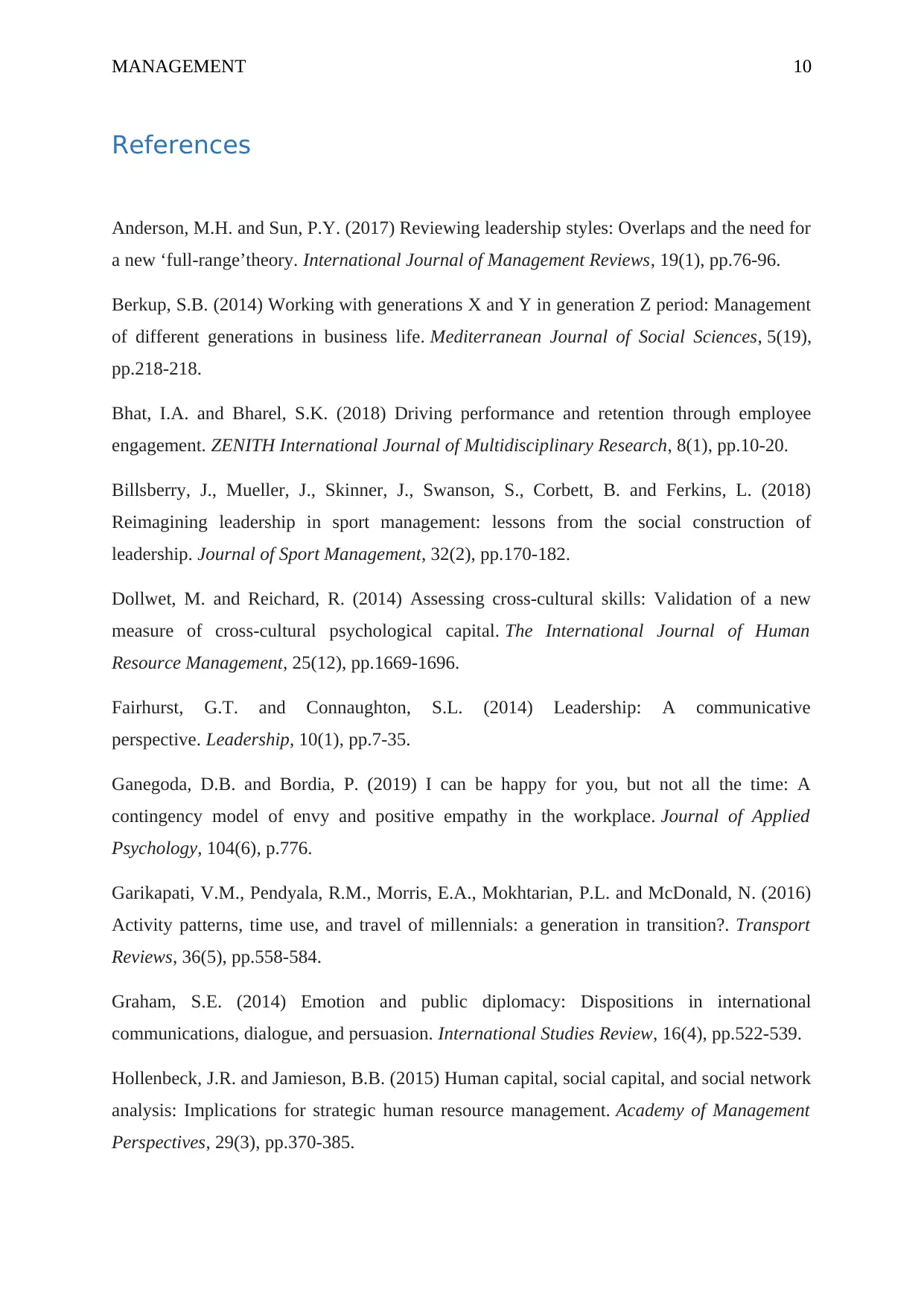
MANAGEMENT 10
References
Anderson, M.H. and Sun, P.Y. (2017) Reviewing leadership styles: Overlaps and the need for
a new ‘full‐range’theory. International Journal of Management Reviews, 19(1), pp.76-96.
Berkup, S.B. (2014) Working with generations X and Y in generation Z period: Management
of different generations in business life. Mediterranean Journal of Social Sciences, 5(19),
pp.218-218.
Bhat, I.A. and Bharel, S.K. (2018) Driving performance and retention through employee
engagement. ZENITH International Journal of Multidisciplinary Research, 8(1), pp.10-20.
Billsberry, J., Mueller, J., Skinner, J., Swanson, S., Corbett, B. and Ferkins, L. (2018)
Reimagining leadership in sport management: lessons from the social construction of
leadership. Journal of Sport Management, 32(2), pp.170-182.
Dollwet, M. and Reichard, R. (2014) Assessing cross-cultural skills: Validation of a new
measure of cross-cultural psychological capital. The International Journal of Human
Resource Management, 25(12), pp.1669-1696.
Fairhurst, G.T. and Connaughton, S.L. (2014) Leadership: A communicative
perspective. Leadership, 10(1), pp.7-35.
Ganegoda, D.B. and Bordia, P. (2019) I can be happy for you, but not all the time: A
contingency model of envy and positive empathy in the workplace. Journal of Applied
Psychology, 104(6), p.776.
Garikapati, V.M., Pendyala, R.M., Morris, E.A., Mokhtarian, P.L. and McDonald, N. (2016)
Activity patterns, time use, and travel of millennials: a generation in transition?. Transport
Reviews, 36(5), pp.558-584.
Graham, S.E. (2014) Emotion and public diplomacy: Dispositions in international
communications, dialogue, and persuasion. International Studies Review, 16(4), pp.522-539.
Hollenbeck, J.R. and Jamieson, B.B. (2015) Human capital, social capital, and social network
analysis: Implications for strategic human resource management. Academy of Management
Perspectives, 29(3), pp.370-385.
References
Anderson, M.H. and Sun, P.Y. (2017) Reviewing leadership styles: Overlaps and the need for
a new ‘full‐range’theory. International Journal of Management Reviews, 19(1), pp.76-96.
Berkup, S.B. (2014) Working with generations X and Y in generation Z period: Management
of different generations in business life. Mediterranean Journal of Social Sciences, 5(19),
pp.218-218.
Bhat, I.A. and Bharel, S.K. (2018) Driving performance and retention through employee
engagement. ZENITH International Journal of Multidisciplinary Research, 8(1), pp.10-20.
Billsberry, J., Mueller, J., Skinner, J., Swanson, S., Corbett, B. and Ferkins, L. (2018)
Reimagining leadership in sport management: lessons from the social construction of
leadership. Journal of Sport Management, 32(2), pp.170-182.
Dollwet, M. and Reichard, R. (2014) Assessing cross-cultural skills: Validation of a new
measure of cross-cultural psychological capital. The International Journal of Human
Resource Management, 25(12), pp.1669-1696.
Fairhurst, G.T. and Connaughton, S.L. (2014) Leadership: A communicative
perspective. Leadership, 10(1), pp.7-35.
Ganegoda, D.B. and Bordia, P. (2019) I can be happy for you, but not all the time: A
contingency model of envy and positive empathy in the workplace. Journal of Applied
Psychology, 104(6), p.776.
Garikapati, V.M., Pendyala, R.M., Morris, E.A., Mokhtarian, P.L. and McDonald, N. (2016)
Activity patterns, time use, and travel of millennials: a generation in transition?. Transport
Reviews, 36(5), pp.558-584.
Graham, S.E. (2014) Emotion and public diplomacy: Dispositions in international
communications, dialogue, and persuasion. International Studies Review, 16(4), pp.522-539.
Hollenbeck, J.R. and Jamieson, B.B. (2015) Human capital, social capital, and social network
analysis: Implications for strategic human resource management. Academy of Management
Perspectives, 29(3), pp.370-385.
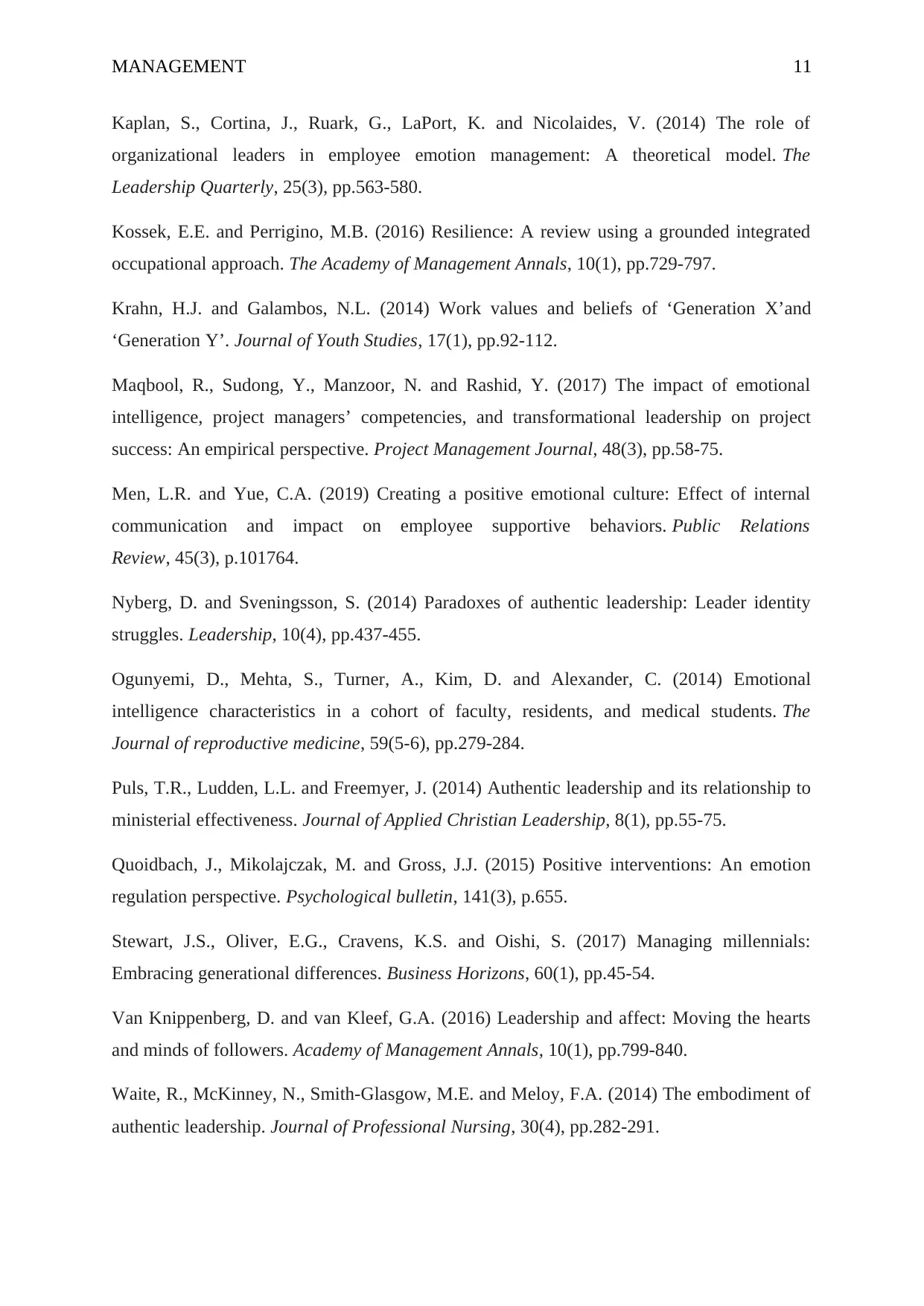
MANAGEMENT 11
Kaplan, S., Cortina, J., Ruark, G., LaPort, K. and Nicolaides, V. (2014) The role of
organizational leaders in employee emotion management: A theoretical model. The
Leadership Quarterly, 25(3), pp.563-580.
Kossek, E.E. and Perrigino, M.B. (2016) Resilience: A review using a grounded integrated
occupational approach. The Academy of Management Annals, 10(1), pp.729-797.
Krahn, H.J. and Galambos, N.L. (2014) Work values and beliefs of ‘Generation X’and
‘Generation Y’. Journal of Youth Studies, 17(1), pp.92-112.
Maqbool, R., Sudong, Y., Manzoor, N. and Rashid, Y. (2017) The impact of emotional
intelligence, project managers’ competencies, and transformational leadership on project
success: An empirical perspective. Project Management Journal, 48(3), pp.58-75.
Men, L.R. and Yue, C.A. (2019) Creating a positive emotional culture: Effect of internal
communication and impact on employee supportive behaviors. Public Relations
Review, 45(3), p.101764.
Nyberg, D. and Sveningsson, S. (2014) Paradoxes of authentic leadership: Leader identity
struggles. Leadership, 10(4), pp.437-455.
Ogunyemi, D., Mehta, S., Turner, A., Kim, D. and Alexander, C. (2014) Emotional
intelligence characteristics in a cohort of faculty, residents, and medical students. The
Journal of reproductive medicine, 59(5-6), pp.279-284.
Puls, T.R., Ludden, L.L. and Freemyer, J. (2014) Authentic leadership and its relationship to
ministerial effectiveness. Journal of Applied Christian Leadership, 8(1), pp.55-75.
Quoidbach, J., Mikolajczak, M. and Gross, J.J. (2015) Positive interventions: An emotion
regulation perspective. Psychological bulletin, 141(3), p.655.
Stewart, J.S., Oliver, E.G., Cravens, K.S. and Oishi, S. (2017) Managing millennials:
Embracing generational differences. Business Horizons, 60(1), pp.45-54.
Van Knippenberg, D. and van Kleef, G.A. (2016) Leadership and affect: Moving the hearts
and minds of followers. Academy of Management Annals, 10(1), pp.799-840.
Waite, R., McKinney, N., Smith-Glasgow, M.E. and Meloy, F.A. (2014) The embodiment of
authentic leadership. Journal of Professional Nursing, 30(4), pp.282-291.
Kaplan, S., Cortina, J., Ruark, G., LaPort, K. and Nicolaides, V. (2014) The role of
organizational leaders in employee emotion management: A theoretical model. The
Leadership Quarterly, 25(3), pp.563-580.
Kossek, E.E. and Perrigino, M.B. (2016) Resilience: A review using a grounded integrated
occupational approach. The Academy of Management Annals, 10(1), pp.729-797.
Krahn, H.J. and Galambos, N.L. (2014) Work values and beliefs of ‘Generation X’and
‘Generation Y’. Journal of Youth Studies, 17(1), pp.92-112.
Maqbool, R., Sudong, Y., Manzoor, N. and Rashid, Y. (2017) The impact of emotional
intelligence, project managers’ competencies, and transformational leadership on project
success: An empirical perspective. Project Management Journal, 48(3), pp.58-75.
Men, L.R. and Yue, C.A. (2019) Creating a positive emotional culture: Effect of internal
communication and impact on employee supportive behaviors. Public Relations
Review, 45(3), p.101764.
Nyberg, D. and Sveningsson, S. (2014) Paradoxes of authentic leadership: Leader identity
struggles. Leadership, 10(4), pp.437-455.
Ogunyemi, D., Mehta, S., Turner, A., Kim, D. and Alexander, C. (2014) Emotional
intelligence characteristics in a cohort of faculty, residents, and medical students. The
Journal of reproductive medicine, 59(5-6), pp.279-284.
Puls, T.R., Ludden, L.L. and Freemyer, J. (2014) Authentic leadership and its relationship to
ministerial effectiveness. Journal of Applied Christian Leadership, 8(1), pp.55-75.
Quoidbach, J., Mikolajczak, M. and Gross, J.J. (2015) Positive interventions: An emotion
regulation perspective. Psychological bulletin, 141(3), p.655.
Stewart, J.S., Oliver, E.G., Cravens, K.S. and Oishi, S. (2017) Managing millennials:
Embracing generational differences. Business Horizons, 60(1), pp.45-54.
Van Knippenberg, D. and van Kleef, G.A. (2016) Leadership and affect: Moving the hearts
and minds of followers. Academy of Management Annals, 10(1), pp.799-840.
Waite, R., McKinney, N., Smith-Glasgow, M.E. and Meloy, F.A. (2014) The embodiment of
authentic leadership. Journal of Professional Nursing, 30(4), pp.282-291.
⊘ This is a preview!⊘
Do you want full access?
Subscribe today to unlock all pages.

Trusted by 1+ million students worldwide
1 out of 13
Related Documents
Your All-in-One AI-Powered Toolkit for Academic Success.
+13062052269
info@desklib.com
Available 24*7 on WhatsApp / Email
![[object Object]](/_next/static/media/star-bottom.7253800d.svg)
Unlock your academic potential
Copyright © 2020–2025 A2Z Services. All Rights Reserved. Developed and managed by ZUCOL.





